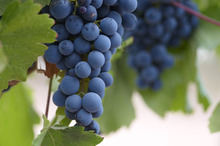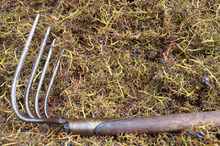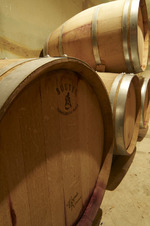Winemaking Protocol
2008 was our starting point or "témoin": a single barrel was made and shows a mix of dried fruits - cherries, figs, plums, some earth and tobacco notes, in a rich, full palate. Hint of bergamot and dried plums in a long finish.
 The purchase of the Versado vineyard in 2008 was completed just as the crop was being harvested, allowing for only a tiny amount of fruit to be retained for the advancement of the project. 2008 became our practical learning baseline – a chance to move from theory to practice – and to learn about the winemaking realities of our newly-gained terroir. The old vines had just been through a really rough patch, enduring two consecutive, unprecedented hail disaster years. This resulted in physical stress to older wood and to young shoots. While the main crop was harvested, we were able to retain a single perfect cluster per vine. We allowed it to hang an extra month before harvesting, resulting in barely enough fruit to make a single barrel of rich, yet structured red wine.
The purchase of the Versado vineyard in 2008 was completed just as the crop was being harvested, allowing for only a tiny amount of fruit to be retained for the advancement of the project. 2008 became our practical learning baseline – a chance to move from theory to practice – and to learn about the winemaking realities of our newly-gained terroir. The old vines had just been through a really rough patch, enduring two consecutive, unprecedented hail disaster years. This resulted in physical stress to older wood and to young shoots. While the main crop was harvested, we were able to retain a single perfect cluster per vine. We allowed it to hang an extra month before harvesting, resulting in barely enough fruit to make a single barrel of rich, yet structured red wine.
So here's the drill
Based on the experience of the winemaking team, and the learning since the 2008 vintage, the following protocol has been developed for Versado:
 Select, perfect bunches are hand harvested into 15 kg lugs.
Select, perfect bunches are hand harvested into 15 kg lugs.- Gentle destemming to shaking, sorting table for hand berry-sorting by 10 meticulous sorters. Imperfect and dehydrated berries are removed, along with bits of stem (jacks).
- To obtain perfect purity and the best possible wine, all juice that comes out of the grapes on the sorting table is sold off to other wineries. Removal in this way of approximately 15 to 22% of our potential volume increases the percentage of structure- and flavour-rich skins in the fermentation, and adds even greater complexity and longevity to the final wine.
- Berries are re-collected in the lug boxes and tipped into a traditional concrete fermenter.
- After a cold-soak of about 72 hours, native yeasts commence fermentation, and are allowed to reached a peak temperature of 30.5 degrees over a three and a half week duration. Minimal temperature regulation is required, due to the thermo-stability of our dense concrete vat.
- The cap is managed through punch downs - one to three per day, dependent on vintage.
 The pomace is gently basket-pressed, and coarse tailles are not retained for Versado. After a 30-hour settling, the wine is racked to fine French oak barrels (40 to 90% new) where malolactic fermentation is allowed to occur naturally, without inoculation.
The pomace is gently basket-pressed, and coarse tailles are not retained for Versado. After a 30-hour settling, the wine is racked to fine French oak barrels (40 to 90% new) where malolactic fermentation is allowed to occur naturally, without inoculation. - Post fermentation, free run wine is delivered to French oak barricas and basket press wine may be reintroduced for structure, if optimal.
- Over the next 20 months, the barrels are racked three times, and egg white fining may be used on some barrels to smooth tannins. After extended blending and tasting trials, involving Ann, Peter and Roberto de la Mota, complex blends of the barrels created our Versado wines. Returned to barrel, and following a period of integration in the cellar, the wines are then bottled.
- Reserva is bottled unfiltered with bottle aging for a minimum of 14 months.
.
